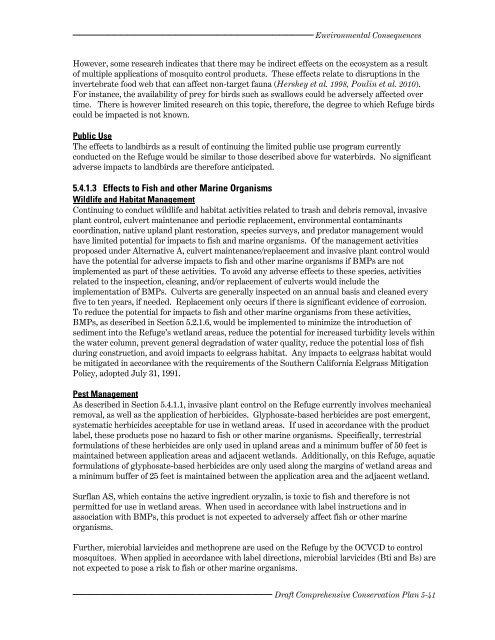Chapters 1 - U.S. Fish and Wildlife Service
Chapters 1 - U.S. Fish and Wildlife Service
Chapters 1 - U.S. Fish and Wildlife Service
You also want an ePaper? Increase the reach of your titles
YUMPU automatically turns print PDFs into web optimized ePapers that Google loves.
Environmental Consequences<br />
However, some research indicates that there may be indirect effects on the ecosystem as a result<br />
of multiple applications of mosquito control products. These effects relate to disruptions in the<br />
invertebrate food web that can affect non-target fauna (Hershey et al. 1998, Poulin et al. 2010).<br />
For instance, the availability of prey for birds such as swallows could be adversely affected over<br />
time. There is however limited research on this topic, therefore, the degree to which Refuge birds<br />
could be impacted is not known.<br />
Public Use<br />
The effects to l<strong>and</strong>birds as a result of continuing the limited public use program currently<br />
conducted on the Refuge would be similar to those described above for waterbirds. No significant<br />
adverse impacts to l<strong>and</strong>birds are therefore anticipated.<br />
5.4.1.3 Effects to <strong>Fish</strong> <strong>and</strong> other Marine Organisms<br />
<strong>Wildlife</strong> <strong>and</strong> Habitat Management<br />
Continuing to conduct wildlife <strong>and</strong> habitat activities related to trash <strong>and</strong> debris removal, invasive<br />
plant control, culvert maintenance <strong>and</strong> periodic replacement, environmental contaminants<br />
coordination, native upl<strong>and</strong> plant restoration, species surveys, <strong>and</strong> predator management would<br />
have limited potential for impacts to fish <strong>and</strong> marine organisms. Of the management activities<br />
proposed under Alternative A, culvert maintenance/replacement <strong>and</strong> invasive plant control would<br />
have the potential for adverse impacts to fish <strong>and</strong> other marine organisms if BMPs are not<br />
implemented as part of these activities. To avoid any adverse effects to these species, activities<br />
related to the inspection, cleaning, <strong>and</strong>/or replacement of culverts would include the<br />
implementation of BMPs. Culverts are generally inspected on an annual basis <strong>and</strong> cleaned every<br />
five to ten years, if needed. Replacement only occurs if there is significant evidence of corrosion.<br />
To reduce the potential for impacts to fish <strong>and</strong> other marine organisms from these activities,<br />
BMPs, as described in Section 5.2.1.6, would be implemented to minimize the introduction of<br />
sediment into the Refuge’s wetl<strong>and</strong> areas, reduce the potential for increased turbidity levels within<br />
the water column, prevent general degradation of water quality, reduce the potential loss of fish<br />
during construction, <strong>and</strong> avoid impacts to eelgrass habitat. Any impacts to eelgrass habitat would<br />
be mitigated in accordance with the requirements of the Southern California Eelgrass Mitigation<br />
Policy, adopted July 31, 1991.<br />
Pest Management<br />
As described in Section 5.4.1.1, invasive plant control on the Refuge currently involves mechanical<br />
removal, as well as the application of herbicides. Glyphosate-based herbicides are post emergent,<br />
systematic herbicides acceptable for use in wetl<strong>and</strong> areas. If used in accordance with the product<br />
label, these products pose no hazard to fish or other marine organisms. Specifically, terrestrial<br />
formulations of these herbicides are only used in upl<strong>and</strong> areas <strong>and</strong> a minimum buffer of 50 feet is<br />
maintained between application areas <strong>and</strong> adjacent wetl<strong>and</strong>s. Additionally, on this Refuge, aquatic<br />
formulations of glyphosate-based herbicides are only used along the margins of wetl<strong>and</strong> areas <strong>and</strong><br />
a minimum buffer of 25 feet is maintained between the application area <strong>and</strong> the adjacent wetl<strong>and</strong>.<br />
Surflan AS, which contains the active ingredient oryzalin, is toxic to fish <strong>and</strong> therefore is not<br />
permitted for use in wetl<strong>and</strong> areas. When used in accordance with label instructions <strong>and</strong> in<br />
association with BMPs, this product is not expected to adversely affect fish or other marine<br />
organisms.<br />
Further, microbial larvicides <strong>and</strong> methoprene are used on the Refuge by the OCVCD to control<br />
mosquitoes. When applied in accordance with label directions, microbial larvicides (Bti <strong>and</strong> Bs) are<br />
not expected to pose a risk to fish or other marine organisms.<br />
Draft Comprehensive Conservation Plan 5-41

















